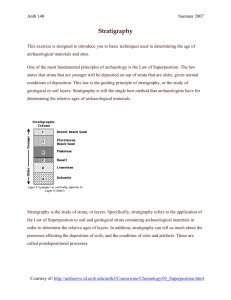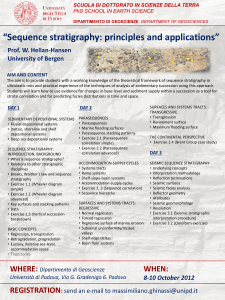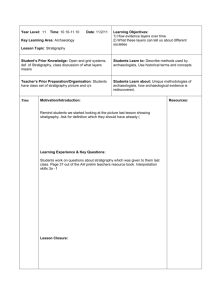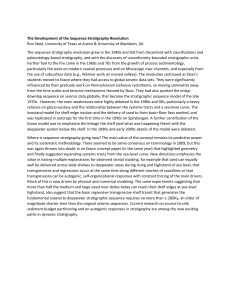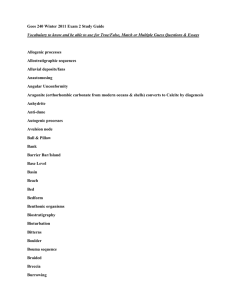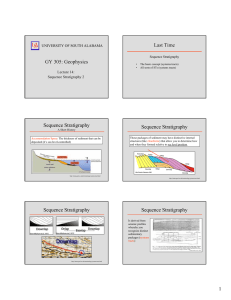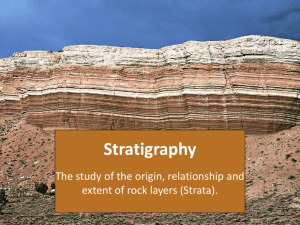Last Time GY 305: Geophysics UNIVERSITY OF SOUTH ALABAMA Seismic Stratigraphy
advertisement
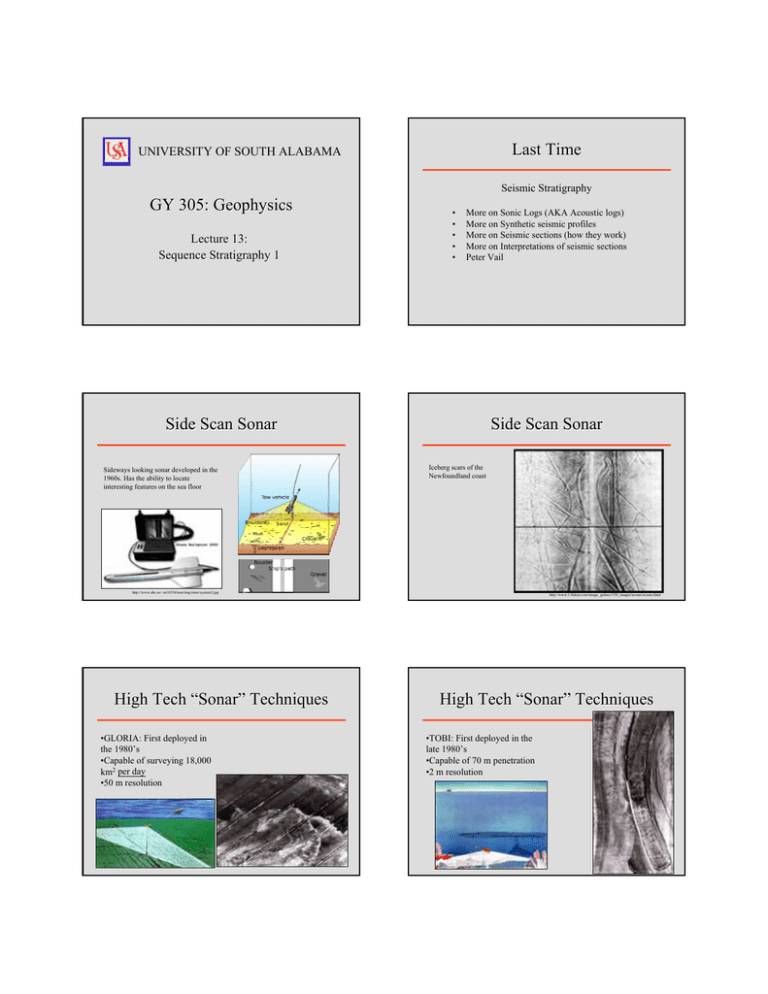
Last Time UNIVERSITY OF SOUTH ALABAMA Seismic Stratigraphy GY 305: Geophysics Lecture 13: Sequence Stratigraphy 1 • • • • • More on Sonic Logs (AKA Acoustic logs) More on Synthetic seismic profiles More on Seismic sections (how they work) More on Interpretations of seismic sections Peter Vail Side Scan Sonar Sideways looking sonar developed in the 1960s. Has the ability to locate interesting features on the sea floor Side Scan Sonar Iceberg scars of the Newfoundland coast http://www.abc.se/~m10354/mar/img/sture/system2.jpg High Tech “Sonar” Techniques •GLORIA: First deployed in the 1980’s •Capable of surveying 18,000 km2 per day •50 m resolution http://www.l-3klein.com/image_gallery/530_images/scours/scours.html High Tech “Sonar” Techniques •TOBI: First deployed in the late 1980’s •Capable of 70 m penetration •2 m resolution Sonic Logs Sonic Logs Ultimately, we are going to have to interpret reflection characteristics of rock units. •Sonic (acoustic logs) display the travel time of P-waves through a formation. •The tool emits a sound wave that travels from the source (T) to the formation and back to receiver(s) (R). Consider controls on reflection strength and polarity… •It is used to establish baseline seismic wave transmission data (e.g., to produce synthetic seismic profiles) http://pangea.stanford.edu/~sklemp/bering_chukchi/images/seismic.section.gif http://www.spwla.org Seismic Stratigraphy Recall from an earlier lab… •Acoustic impedance of a formation (1) is simply defined as: a1 = v1 x d1 v1 = the velocity of a seismic wave d1 = rock density http://homepage.ufp.pt/biblioteca/GlossarySaltTectonics/PlatesJPG/Fig.A001b-AcousticImpedance.jpg http://openlearn.open.ac.uk/file.php/2292/S278_1_022i.jpg Sequence Stratigraphy Today A Short History "Pete's ideas evolved naturally from his first pioneering work on the importance of stratal surfaces in rocks as geologic time lines," wrote Robert Mitchum, a longtime friend and former Exxon colleague. "He soon recognized the cyclic occurrence of bundles of strata he called sequences in well logs, seismic reflections and outcrops. "Observing that sequence boundaries appear synchronous globally, he postulated that cyclic eustatic sea level changes are major controls on stratigraphy, along with basin tectonics and sediment supply," Mitchum said. "This realization led to the development of eustatic cycle charts”. (2003 AAPG Address) Sequence Stratigraphy • • • The basic concept (systems tracts) All sorts of STs (systems tracts) sea level change Sequence Stratigraphy Sequence Stratigraphy A Short History A Short History The “Vail Curve” is synonymous with eustasy And is used by everyone in soft rock geology. •stratigraphers •sedimentologists •paleontologists •petroleum geol. Sequence Stratigraphy Sequence Stratigraphy A Short History A Short History Why? Because sea level controls what sediment is produced and where it is deposited. http://strata.geol.sc.edu/terminology/system-tract.html Accommodation Space: The thickness of sediment that can be deposited (it’s sea level-controlled) http://strata.geol.sc.edu/terminology/system-tract.html Sequence Stratigraphy Sequence Stratigraphy A Short History A Short History Accommodation Space: Note: Vail’s surfaces actually define packages of sedimentary rock. (+) with sea level highstands; Those associated with specific states of sea level are called systems tracts. (-) with sea level lowstands http://strata.geol.sc.edu/terminology/system-tract.html http://strata.geol.sc.edu/terminology/system-tract.html Sequence Stratigraphy (System Tracts) System Tracts come in numerous styles and are named according to sea level position/state during deposition. The 6 most important are Sequence Stratigraphy (System Tracts) LST: Low stand systems tract: includes deposits that accumulate after the onset of relative a sea-level rise. 1) LST: Low stand systems tract 2) HST: High stand systems tract 3) TST: Transgressive systems tract 4) FSST: Falling stage systems tract 5) RST: Regressive systems tract 6) FRST: Forced regressive systems tract http://strata.geol.sc.edu/terminology/system-tract.html Sequence Stratigraphy (System Tracts) Sequence Stratigraphy (System Tracts) LST: Low stand systems tract: includes deposits that accumulate after the onset of relative a sea-level rise. LST: Low stand systems tract: includes deposits that accumulate after the onset of relative a sea-level rise. Lowstand Systems Tract sediments often fill or partially infill incised valleys that were cut into the Highstand Systems Tract, and other earlier deposits, during the FSST. Lowstand Systems Tract sediments often fill or partially infill incised valleys that were cut into the Highstand Systems Tract, and other earlier deposits, during the FSST. Stacking patterns exhibit [backstepping, onlapping, retrogradational, aggrading clinoforms that thicken updip]. http://strata.geol.sc.edu/terminology/system-tract.html Sequence Stratigraphy (System Tracts) Sequence Stratigraphy (System Tracts) Remember that you are doing all this via seismic traces Remember that you are doing all this via seismic traces. The nature of the surfaces can tell you the stage(s) of sea level during deposition. Clinoforms are parallel but inclined surfaces http://strata.geol.sc.edu/terminology/system-tract.html Sequence Stratigraphy (System Tracts) http://strata.geol.sc.edu/terminology/system-tract.html Sequence Stratigraphy (System Tracts) Sequence Stratigraphy (System Tracts) http://strata.geol.sc.edu/terminology/system-tract.html Sequence Stratigraphy (System Tracts) LST: Low stand systems tract: includes deposits that accumulate after the onset of relative a sea-level rise. http://strata.geol.sc.edu/terminology/system-tract.html Sequence Stratigraphy (System Tracts) HST: High stand systems tract: the progradational deposits that form when sediment accumulation rates exceed the rate of increase in accommodation space. Stacking patterns exhibit prograding aggrading clinoforms that thin upward. http://strata.geol.sc.edu/terminology/system-tract.html http://strata.geol.sc.edu/terminology/system-tract.html Sequence Stratigraphy (System Tracts) HST: High stand systems tract: the progradational deposits that form when sediment accumulation rates exceed the rate of increase in accommodation space. Stacking patterns exhibit prograding aggrading clinoforms that thin upward. http://strata.geol.sc.edu/terminology/system-tract.html Upcoming Stuff Wednesday: More Sequence Stratigraphy Thursday’s Lab Seismic Stratigraphy Lab (2 weeker)
